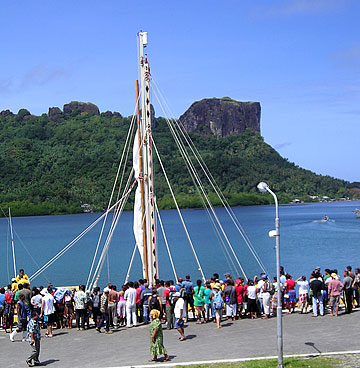
GARY T. KUBOTA / GKUBOTA@STARBULLETIN.COM
A crowd greeted the arrival of the Hawaiian double-hulled sailing canoes Hokule'a and Alingano Maisu at Kolonia Harbor in Pohnpei this morning (yesterday in Hawaii). CLICK FOR LARGE
|
|
Canoes visit cradle of voyaging tradition
A 760-mile leg of the perilous journey is completed
KOLONIA, Pohnpei » After seven days at sea, sometimes in thick rain, steering only by Pacific native way-finding methods, the crew of the double-hulled sailing canoes Hokule'a and Alingano Maisu arrived in the Federated States of Micronesia, the home nation of renowned navigator Mau Piailug.
The 760-mile journey from Majuro to Pohnpei was the second-longest crossing in a more than 2,900-mile journey to fulfill a promise to deliver the gift of the Alingano Maisu to Mau for his contribution in teaching Pacific way-finding navigation to native Hawaiians and sparking a renaissance in canoe voyaging 30 years ago.

FOLLOW ALONG» Follow the voyage of Hokule'a at the Polynesian Voyaging Society web site at: www.pvs.hawaii.org
» Star-Bulletin reporter Gary Kubota is sailing with Hokule'a and will respond to selected reader questions from the canoe via satellite hookup, when possible. Email questions to hokulea@starbulletin.com
|
The Hokule'a and Alingano Maisu arrived at the main dock in Kolonia Harbor this morning (yesterday in Hawaii), after spending the night at a nearby cove.
Traditional chiefs of Pohnpei greeted the Hawaiian crews with a ceremony, followed by the presentation of perfume oil and garlands.
Salvadore Iriate, representing the Pohnpei chiefs, said he was proud that native Hawaiians regard a Micronesian as the father of their voyaging canoes.
The Pohnpei chiefs bestowed the title of navigator to Big Island resident Chadd Paishon, who has been the navigator of the Alingano Maisu.
Suzanne Hale, U.S. ambassador to the Federated States, said the voyage represented a major accomplishment for Micronesians and Hawaiians in cultural exchange and education.
Hale said the voyage has generated a great deal of interest worldwide, especially among schoolchildren.
"This really has an impact on kids all over the Pacific and getting them more interested in traditional cultures," Hale said.
The crews will be visiting schools in Pohnpei to give talks on voyaging and will conduct tours of the vessel during a four-day stop before sailing to Chuuk.
Difficult crossing
The trip to Pohnpei had been difficult at times for the crew of 11, with weather conditions shifting continuously, prompting them to change sails and sometimes drop all sails to prevent squalls from ripping canvas.
During most nights the crew wore foul-weather gear, and occasionally they were visited by torrential rain that dropped visibility to a quarter-mile.
When there was no sight of stars or moon at night, Hawaiian native way-finding navigator Bruce Blankenfeld sailed in a western direction to Pohnpei by observing the direction of ocean swells and the wind.
On a couple of nights, the Hokule'a crew was visited by a school of dolphins swimming along its sides.
The crew, led by catch supervisor Tim Gilliom, caught several fish for dinner, including a mahimahi, aku and dogtooth tuna.
About a day before their arrival, crew members' moods lightened when they noticed coconuts bobbing in the water, then white terns, land-based birds that fly out in the morning to hunt at sea and fly in the evening to return to an island.
The terns were flying in an easterly direction yesterday morning (Pohnpei time), indicating the Hokule'a was headed in the right direction by sailing westward.
Occasionally, when the wind has virtually died, the Hokule'a and Alingano Maisu have received a tow from the escort vessel Kama Hele.
Blankenfeld advised the crew yesterday morning to be on the lookout for Pohnpei, but while the rain had ceased, clouds covered most of the horizon.
Then, out of a gathering of gray clouds to the southwest emerged dark outlines rising gently from the sea and the growing sound of booming surf.
"There it is. There it is," said Atwood Makanani, standing on the bow and pointing toward Pohnpei.
The next stop is Chuuk, a distance of some 120 miles and about a day's sail from Pohnpei.
Once the trip to Micronesia is completed, the Hokule'a plans to sail north to Okinawa by April 1, before the beginning of typhoon season.
World War II scars Micronesia's past
For a number of Americans, islands in the Federated States of Micronesia are footnotes in the history of World War II.
The 607 islands in a 271-square-mile area are located in a strategic zone for shipping and have been conquered by a succession of nations.
Islands, such as Chuuk, were sites of fierce naval bombardments.
Out of the scars of war and colonization, first with the Spanish, then Germans, Japanese and Americans, the more than 136,000 Micronesians in the Federated States have become an independent nation. But they have been struggling to develop economically.
About a fourth of the Federated States' population lives in the United States, according to federal officials.
A significant amount of the nation's income comes from U.S. aid, an outgrowth of it signing a compact allowing the United States to control military access to its waters.
Tourism has become an emerging industry.
With sunken World War II vessels still at the bottom, Chuuk lagoon has become a favorite dive location for American visitors.
On Pohnpei the ocean canals of Nan Madol, known as the Venice of the Pacific, serve as reminders of a Pacific people with a strong tradition in sailing.
But Micronesians have been facing a number of problems, including global warming and rising seas, as well as a Western diet and lifestyle that are significantly shortening people's lives.

